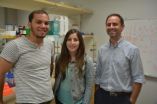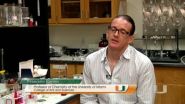(Press-News.org) PHILADELPHIA — The longer a person took low-dose aspirin, the lower his or her risk for developing pancreatic cancer, according to a study published in Cancer Epidemiology, Biomarkers & Prevention, a journal of the American Association for Cancer Research.
"We found that the use of low-dose aspirin was associated with cutting the risk of pancreatic cancer in half, with some evidence that the longer low-dose aspirin was used, the lower the risk," said Harvey A. Risch, MD, PhD, professor of epidemiology in the Department of Chronic Disease Epidemiology at the Yale School of Public Health in New Haven, Connecticut. "Because about one in 60 adults will get pancreatic cancer and the five-year survival rate is less than 5 percent, it is crucial to find ways to prevent this disease."
Men and women who took low-dose aspirin regularly had 48 percent reduction in their risk for developing pancreatic cancer. Protection against pancreatic cancer ranged from 39 percent reduction in risk for those who took low-dose aspirin for six years or less, to 60 percent reduction in risk for those who took low-dose aspirin for more than 10 years.
"Older studies of aspirin use have been clouded by the use of [regular- or high-dose] aspirin for pain relief from conditions that themselves might be related to the risk for pancreatic cancer. Only recently have people been using low-dose aspirin for long enough times [to prevent cardiovascular disease] that the use might bear on risk of pancreatic cancer development," explained Risch.
"There seems to be enough evidence that people who are considering aspirin use to reduce the risk for cardiovascular disease can feel positive that their use might also lower their risk for pancreatic cancer, and quite certainly wouldn't raise it," Risch added.
Study subjects were recruited from the 30 general hospitals in Connecticut between 2005 and 2009. There were 362 pancreatic cancer cases and 690 controls. Study subjects were interviewed in person to determine when they started using aspirin, the number of years they used aspirin, the type of aspirin they used (low versus regular dose), and when they stopped using aspirin, among other things. Confounding factors, including body mass index, smoking history, and history of diabetes, were taken into account.
Of the study participants, 57 percent were men, about 92 percent were non-Hispanic white, about 49 percent were former or current smokers, and 19 percent had been diagnosed with diabetes within the three years prior to this study.
A dose of 75 to 325 mg of aspirin per day was considered as low-dose aspirin (usually taken for heart-disease prevention), and a dose higher than that, generally taken every four to six hours, was considered as regular-dose aspirin taken for pain or anti-inflammation purposes.
Of the participants, 96 percent of low-dose aspirin users and 92 percent of regular-dose aspirin users reported daily aspirin use.
The earlier a person started regularly taking low-dose aspirin, the greater the pancreatic cancer risk reduction, ranging from 48 percent reduction in those who started three years before the study, to 60 percent in those who started taking it 20 years before the study. On the other hand, discontinuation of aspirin use within two years prior to the study was associated with a threefold increased risk for pancreatic cancer compared with continuing use.
"People who are developing pancreatic cancer have various physiologic changes, including taste disorders, starting to occur two to three years before pancreatic cancer is diagnosed. Such individuals are more likely to quit using aspirin. So it may be tricky to separate the various aspects of patterns of aspirin use and risk of pancreatic cancer," noted Risch.
"Aspirin use has potential risks of its own, and thus the risks and benefits for each person have to be evaluated based on personal characteristics and considerations," added Risch. "For the small subset of individuals with strong family histories of pancreatic cancer or who otherwise have been evaluated to be at substantially increased risk of pancreatic cancer, aspirin use could be part of a regimen designed to reduce their risk."
INFORMATION:
This study was funded by the National Cancer Institute. Risch declares no conflicts of interest.
Follow the AACR on Twitter: @AACR
Follow the AACR on Facebook: http://www.facebook.com/aacr.org
About the American Association for Cancer Research
Founded in 1907, the American Association for Cancer Research (AACR) is the world's oldest and largest professional organization dedicated to advancing cancer research and its mission to prevent and cure cancer. AACR membership includes more than 34,000 laboratory, translational, and clinical researchers; population scientists; other health care professionals; and cancer advocates residing in more than 90 countries. The AACR marshals the full spectrum of expertise of the cancer community to accelerate progress in the prevention, biology, diagnosis, and treatment of cancer by annually convening more than 20 conferences and educational workshops, the largest of which is the AACR Annual Meeting with more than 18,000 attendees. In addition, the AACR publishes eight peer-reviewed scientific journals and a magazine for cancer survivors, patients, and their caregivers. The AACR funds meritorious research directly as well as in cooperation with numerous cancer organizations. As the Scientific Partner of Stand Up To Cancer, the AACR provides expert peer review, grants administration, and scientific oversight of team science and individual grants in cancer research that have the potential for near-term patient benefit. The AACR actively communicates with legislators and policymakers about the value of cancer research and related biomedical science in saving lives from cancer. For more information about the AACR, visit http://www.AACR.org.
Continued use of low-dose aspirin may lower pancreatic cancer risk
2014-06-26
ELSE PRESS RELEASES FROM THIS DATE:
Revisions needed for current IV feeding safeguards against bloodstream infections
2014-06-26
Current guidelines to help prevent bloodstream infections during intravenous feeding may need
revisions to strengthen protections for patients, a new study finds.
Researchers at the United Kingdom's University of Southampton found that current guidelines do not account for other independent factors that can affect the growth of potentially deadly microorganisms. Their study was published today in the OnlineFirst version of the Journal of
Parenteral and Enteral Nutrition (JPEN), the research journal of the American Society for Parenteral and Enteral Nutrition (A.S.P.E.N.). ...
Researchers call for patients who receive home nutritional care to have emergency plans
2014-06-26
On the heels of the 2014 hurricane season, researchers are calling for home parenteral and enteral nutrition (HPEN) consumers and their homecare providers to have a comprehensive emergency preparedness plan (EPP) to ensure that special needs are met during the time of a disaster.
In a paper published today in the American Society for Parenteral and Enteral Nutrition's (A.S.P.E.N.) Nutrition in Clinical Practice journal, researchers with Coram Specialty Infusion Services outline the experiences of HPEN consumers and homecare providers in New Jersey affected by Hurricane ...
Researchers discover 'Trojan Horse' method of penetrating cellular walls without harm
2014-06-26
COLLEGE STATION – Scientists with Texas A&M AgriLife Research have found a "Trojan horse" way to deliver proteins into live human cells without damaging them.
The finding, published in this month's Nature Methods, is expected to be easily adopted for use in medical research to find cures and treatments for a wide range of diseases, according to the team's lead scientist, Dr. Jean-Philippe Pellois, an associate professor of biochemistry at Texas A&M University.
"This is something that for many years people have tried to do, because proteins are basic components of the ...
Invasive watersnakes introduced to California may pose risk to native species
2014-06-26
Watersnakes, commonly seen in the lakes, rivers and streams of the eastern United States, are invading California waterways and may pose a threat to native and endangered species in the state, according to a University of California, Davis, study.
While scientists do not know exactly how many watersnakes are in California, roughly 300 individuals of two different species –the common watersnake and the southern watersnake -- have been found in the Sacramento area (Roseville and Folsom), and at least 150 were seen in Long Beach. Researchers suspect the nonvenomous snakes ...
Sequencing efforts miss DNA crucial to bacteria's disease causing power
2014-06-26
Genomic sequencing is supposed to reveal the entire genetic makeup of an organism. For infectious disease specialists, the technology can be used to analyze a disease-causing bacterium to determine how much harm it is capable of causing and whether or not it will be resistant to antibiotics. But new research at Rockefeller University suggests that current sequencing protocols overlook crucial bits of information: isolated pieces of DNA floating outside the bacterial chromosome, the core of a cell's genetic material.
"Extensive sequencing of chromosomal DNA has been performed ...
A win-win-win solution for biofuel, climate, and biodiversity
2014-06-25
Fossil fuel emissions release billions of tons of carbon into the atmosphere each year, which is changing the climate and threatening the sustainability of life on planet Earth. In Brazil, the demand for alternative energy sources has led to an increase in biofuel crops. A new "News and Views" paper in Nature Climate Change, co-authored by Woods Hole Research Center scientists Marcia Macedo and Eric Davidson, reviews new research conducted by Brazilian colleagues demonstrating the high carbon costs of converting intact Brazilian savanna compared to the carbon gains obtained ...
Scientists develop a 'nanosubmarine' that delivers complementary molecules inside cells
2014-06-25
VIDEO:
Francisco Raymo discusses his work in this video.
Click here for more information.
CORAL GABLES, Fla. (June 25, 2014) — With the continuing need for very small devices in therapeutic applications, there is a growing demand for the development of nanoparticles that can transport and deliver drugs to target cells in the human body.
Recently, researchers created nanoparticles that under the right conditions, self-assemble – trapping complementary guest molecules within ...
NASA's STEREO maps much larger solar atmosphere than previously observed
2014-06-25
Surrounding the sun is a vast atmosphere of solar particles, through which magnetic fields swarm, solar flares erupt, and gigantic columns of material rise, fall and jostle each other around. Now, using NASA's Solar Terrestrial Relations Observatory, scientists have found that this atmosphere, called the corona, is even larger than thought, extending out some 5 million miles above the sun's surface -- the equivalent of 12 solar radii. This information has implications for NASA's upcoming Solar Probe Plus mission, due to launch in 2018 and go closer to the sun than any man-made ...
New NASA model gives glimpse into the invisible world of electric asteroids
2014-06-25
Space may appear empty -- a soundless vacuum, but it's not an absolute void. It flows with electric activity that is not visible to our eyes. NASA is developing plans to send humans to an asteroid, and wants to know more about the electrical environment explorers will encounter there.
A solar wind blown from the surface of the sun at about a million miles per hour flows around all solar system objects, forming swirling eddies and vortices in its wake. Magnetic fields carried by the solar wind warp, twist, and snap as they slam into the magnetic fields around other objects ...
Carbon-fiber epoxy honeycombs mimic the material performance of balsa wood
2014-06-25
Cambridge, Mass. – June 25, 2014 – In wind farms across North America and Europe, sleek turbines equipped with state-of-the-art technology convert wind energy into electric power. But tucked inside the blades of these feats of modern engineering is a decidedly low-tech core material: balsa wood.
Like other manufactured products that use sandwich panel construction to achieve a combination of light weight and strength, turbine blades contain carefully arrayed strips of balsa wood from Ecuador, which provides 95 percent of the world's supply.
For centuries, the fast-growing ...





